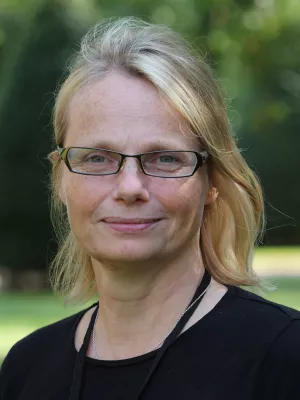
Sara Brogaard
Senior Lecturer

Pathways to future cropland : Assessing uncertainties in socio-economic processes by applying a global land-use model
Author
Summary, in English
based on expanding cropland and pastures, as well as the intensification of agriculture, including increased use of
high yielding crop varieties, machinery, irrigation, artificial fertilisers, and pesticides. Both, agricultural
intensification and the expansion of agricultural land-use lead to environmental degradation, pose threats to
human health, and contribute to climate change. Transitioning towards sustainable agricultural land use, therefore,
is one of the major challenges facing humanity in the 21st century. This challenge is aggravated by the need to
feed the growing and increasingly affluent population, the effects of climate change on agriculture and the
increasing demand for land to mitigate climate change, through for example bioenergy production. This thesis
assesses how uncertainties in the development of socio-economic drivers and processes, such as population
growth, dietary shifts, technological change, and bioenergy production, affect the outcome of future land-use and
land cover change (LULCC). Future development of socio-economic drivers and climate forcing are described by
the latest scenarios developed for environmental and climate-change research, i.e. the Shared Socio-economic
Pathways (SSPs) and the Representative Concentration Pathways (RCPs). The impacts of the changing drivers
on the land system are assessed with the global Parsimonious Land Use Model (PLUM). PLUM was shown to
reproduce observed global agricultural land use change at the global to country scale for 1991-2010. Future global
cropland changes were found to be very sensitive to the assumed yield growth rate. In a subsequent study,
estimates of future yield were therefore derived with a global dynamic vegetation model, and included impacts of
climate change. Without assumed land-based mitigation strategies, simulated future cropland ranged from 970 to
2280 Mha by 2100, compared to current cropland area of 1500 Mha. This range is consistent with those found in
the recently published literature. Accounting for the uncertainties related to the interpretation of socio-economic
processes and drivers described in the scenarios expanded the simulated range for global cropland to 890-2380
Mha (± one standard deviation) by 2100 and led to strongly overlapping cropland ranges for three out of five
scenarios. Uncertainties related to scenario interpretation are thus of similar importance as uncertainties across
different models for estimating the possible outcome of future LULCC. When land-based climate change mitigation
strategies are considered, additional cropland requirements of 603-1115 Mha by 2100 were simulated for the
production of bioenergy. However, considerable uncertainties related to the strength of mitigation efforts and crop
yields accompany this estimate. Continuous expansion of cropland into grasslands and forest, as in scenarios with
strong population growth and low technological change or scenarios with large bioenergy production, was
simulated to transform the terrestrial biosphere from a carbon sink into a carbon source. Moreover, remaining
within the estimated planetary boundary for global cropland (15% of ice-free land) is not possible when aiming to
ensure food security while simultaneously producing bioenergy that significantly contributes to strong climatechange
mitigation efforts by 2050. In a local to regional case study future food security was shown to be at risk
under the assumed future socio-economic developments, demonstrated here for countries in the Sahel region of
Africa. Implementing sustainable agricultural management practices as well as global trade will be important to
ensure food security in the future. Overall, uncertainties in population development, technological change,
resource intensity and land degradation were shown to contribute to a wide range of future agricultural LULCC.
Department/s
- Dept of Physical Geography and Ecosystem Science
- BECC: Biodiversity and Ecosystem services in a Changing Climate
Publishing year
2016-08
Language
English
Full text
Document type
Dissertation
Publisher
Department of Physical Geography and Ecosystem Science, Faculty of Science, Lund University
Topic
- Geosciences, Multidisciplinary
Keywords
- land-use and land cover change
- socio-economic modelling
- scenarios
- uncertainties
Status
Published
Supervisor
- Almut Arneth
- Mark D. A. Rounsevell
- Jonathan Seaquist
- Sara Brogaard
ISBN/ISSN/Other
- ISBN: 978-91-85793-62-4
- ISBN: 978-91-85793-61-7
Defence date
26 September 2016
Defence time
10:00
Defence place
Geocentre I, lecture hall “Världen”, Sölvegatan 10, Lund
Opponent
- Jed O. Kaplan (Professor)